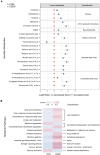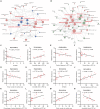Altered Fecal Metabolites and Colonic Glycerophospholipids Were Associated With Abnormal Composition of Gut Microbiota in a Depression Model of Mice
- PMID: 34349620
- PMCID: PMC8326978
- DOI: 10.3389/fnins.2021.701355
Altered Fecal Metabolites and Colonic Glycerophospholipids Were Associated With Abnormal Composition of Gut Microbiota in a Depression Model of Mice
Abstract
The microbiota-gut-brain axis has been considered to play an important role in the development of depression, but the underlying mechanism remains unclear. The gastrointestinal tract is home to trillions of microbiota and the colon is considered an important site for the interaction between microbiota and host, but few studies have been conducted to evaluate the alterations in the colon. Accordingly, in this study, we established a chronic social defeated stress (CSDS) mice model of depression. We applied 16S rRNA gene sequencing to assess the gut microbial composition and gas and liquid chromatography-mass spectroscopy to identify fecal metabolites and colonic lipids, respectively. Meanwhile, we used Spearman's correlation analysis method to evaluate the associations between the gut microbiota, fecal metabolites, colonic lipids, and behavioral index. In total, there were 20 bacterial taxa and 18 bacterial taxa significantly increased and decreased, respectively, in the CSDS mice. Further, microbial functional prediction demonstrated a disturbance of lipid, carbohydrate, and amino acid metabolism in the CSDS mice. We also found 20 differential fecal metabolites and 36 differential colonic lipids (in the category of glycerolipids, glycerophospholipids, and sphingolipids) in the CSDS mice. Moreover, correlation analysis showed that fecal metabolomic signature was associated with the alterations in the gut microbiota composition and colonic lipidomic profile. Of note, three lipids [PC(16:0/20:4), PG(22:6/22:6), and PI(18:0/20:3), all in the category of glycerophospholipids] were significantly associated with anxiety- and depression-like phenotypes in mice. Taken together, our results indicated that the gut microbiota might be involved in the pathogenesis of depression via influencing fecal metabolites and colonic glycerophospholipid metabolism.
Keywords: chronic social defeated stress; colonic lipids; fecal metabolome; glycerophospholipids; gut microbiota; microbiota–gut–brain axis.
Copyright © 2021 Gong, Huang, Yang, Chen, Pu, He and Xie.
Conflict of interest statement
The authors declare that the research was conducted in the absence of any commercial or financial relationships that could be construed as a potential conflict of interest.
Figures






Similar articles
-
Multi-omics data reveals the important role of glycerophospholipid metabolism in the crosstalk between gut and brain in depression.J Transl Med. 2023 Feb 7;21(1):93. doi: 10.1186/s12967-023-03942-w. J Transl Med. 2023. PMID: 36750892 Free PMC article.
-
Fecal metabonomics combined with 16S rRNA gene sequencing to analyze the changes of gut microbiota in rats with kidney-yang deficiency syndrome and the intervention effect of You-gui pill.J Ethnopharmacol. 2019 Nov 15;244:112139. doi: 10.1016/j.jep.2019.112139. Epub 2019 Aug 8. J Ethnopharmacol. 2019. PMID: 31401318
-
Gut microbiota causes depressive phenotype by modulating glycerophospholipid and sphingolipid metabolism via the gut-brain axis.Psychiatry Res. 2025 Apr;346:116392. doi: 10.1016/j.psychres.2025.116392. Epub 2025 Feb 7. Psychiatry Res. 2025. PMID: 39933221
-
Multi-omics data reveals the disturbance of glycerophospholipid metabolism caused by disordered gut microbiota in depressed mice.J Adv Res. 2022 Jul;39:135-145. doi: 10.1016/j.jare.2021.10.002. Epub 2021 Oct 13. J Adv Res. 2022. PMID: 35777903 Free PMC article.
-
Fecal 16S rRNA sequencing and multi-compartment metabolomics revealed gut microbiota and metabolites interactions in APP/PS1 mice.Comput Biol Med. 2022 Dec;151(Pt A):106312. doi: 10.1016/j.compbiomed.2022.106312. Epub 2022 Nov 17. Comput Biol Med. 2022. PMID: 36417828
Cited by
-
Chronic Sleep Deprivation Causes Anxiety, Depression and Impaired Gut Barrier in Female Mice-Correlation Analysis from Fecal Microbiome and Metabolome.Biomedicines. 2024 Nov 21;12(12):2654. doi: 10.3390/biomedicines12122654. Biomedicines. 2024. PMID: 39767560 Free PMC article.
-
Association Between Abnormal Plasma Lipid Metabolism and Psychological Characteristics in Adolescents With Major Depressive Disorder.Depress Anxiety. 2025 May 12;2025:5564796. doi: 10.1155/da/5564796. eCollection 2025. Depress Anxiety. 2025. PMID: 40390837 Free PMC article.
-
Recent Progress in Mass Spectrometry-Based Metabolomics in Major Depressive Disorder Research.Molecules. 2023 Nov 4;28(21):7430. doi: 10.3390/molecules28217430. Molecules. 2023. PMID: 37959849 Free PMC article. Review.
-
Peripheral metabolic alterations associated with pathological manifestations of Parkinson's disease in gut-brain axis-based mouse model.Front Mol Neurosci. 2023 Aug 10;16:1201073. doi: 10.3389/fnmol.2023.1201073. eCollection 2023. Front Mol Neurosci. 2023. PMID: 37635904 Free PMC article.
-
Multi-omics data reveals the important role of glycerophospholipid metabolism in the crosstalk between gut and brain in depression.J Transl Med. 2023 Feb 7;21(1):93. doi: 10.1186/s12967-023-03942-w. J Transl Med. 2023. PMID: 36750892 Free PMC article.
References
-
- Akkasheh G., Kashani-Poor Z., Tajabadi-Ebrahimi M., Jafari P., Akbari H., Taghizadeh M., et al. (2016). Clinical and metabolic response to probiotic administration in patients with major depressive disorder: a randomized, double-blind, placebo-controlled trial. Nutrition 32 315–320. 10.1016/j.nut.2015.09.003 - DOI - PubMed
-
- Burokas A., Arboleya S., Moloney R. D., Peterson V. L., Murphy K., Clarke G., et al. (2017). Targeting the Microbiota-Gut-Brain Axis: prebiotics Have Anxiolytic and Antidepressant-like Effects and Reverse the Impact of Chronic Stress in Mice. Biol. Psychiatry 82 472–487. 10.1016/j.biopsych.2016.12.031 - DOI - PubMed
-
- Chen H., Xie H., Huang S., Xiao T., Wang Z., Ni X., et al. (2020). Development of mass spectrometry-based relatively quantitative targeted method for amino acids and neurotransmitters: applications in the diagnosis of major depression. J. Pharm. Biomed. Anal. 194:113773. 10.1016/j.jpba.2020.113773 - DOI - PubMed
LinkOut - more resources
Full Text Sources
Research Materials
Miscellaneous

